No products in the cart.
NEWS
Transform Your Streets: Best Flowering Trees for Roadside Planting
Enhancing our urban landscapes with vibrant greenery and beautiful flowers not only elevates aesthetic appeal but also contributes significantly to environmental health. Flowering plants and trees strategically planted along roadsides offer a myriad of benefits, from reducing air pollution and absorbing dust to mitigating traffic noise. As experts in horticulture at Biogarden.asia, we understand the power of selecting the right species to create stunning and functional streetscapes. Let’s explore some of the most captivating flowering trees and plants perfect for bringing life and color to your surroundings.
Why Choose Flowering Trees for Roadsides?
Beyond their obvious beauty, flowering plants serve crucial ecological functions in urban environments. They act as natural filters, trapping airborne pollutants and dust particles that are prevalent near busy roads. Their foliage can help absorb and deflect traffic noise, creating quieter public spaces. Furthermore, they provide shade, help manage stormwater runoff, and support local biodiversity by attracting pollinators like bees and butterflies. Choosing species specifically adapted to the challenges of roadside conditions ensures these benefits are sustained.
Key Characteristics of Ideal Roadside Plants
Selecting plants for areas adjacent to roads requires careful consideration. These locations often present harsh conditions, including compacted soil, limited water availability (except for runoff), exposure to pollutants, road salt (in some climates), and temperature extremes. Therefore, suitable street-side plants typically possess:
- Compact or Manageable Size: Avoiding plants that grow too large and obstruct views or utility lines.
- Hardiness and Resilience: Ability to tolerate urban stress, pollution, and varying weather conditions.
- Low Maintenance: Minimal requirements for watering, fertilizing, and pruning once established.
- Adaptability: Tolerance to a range of soil types and light conditions.
- Aesthetic Appeal: Vibrant colors and attractive form, often with extended flowering periods, sometimes evergreen bloomers.
Top Flowering Trees and Plants for Street-Side Beauty
Many species fit the criteria for successful roadside planting, each offering unique characteristics and visual charm. Here is a selection of popular and effective choices that can brighten any street.
Golden Dewdrop (Duranta erecta)
Golden Dewdrop, also known as Pigeon Berry or Skyflower, is a popular choice for gardens and landscaping, often used along roadsides and in public green spaces. Its appeal comes from its beautiful clusters of purple or white flowers and distinctive golden-orange berries. This plant typically grows as a shrub or small tree, reaching heights of 1-3 meters, but can occasionally exceed 5 meters depending on conditions. It’s favored for its ease of cultivation and care, not being overly demanding regarding soil type and requiring only moderate sunlight, making it adaptable to various urban environments.
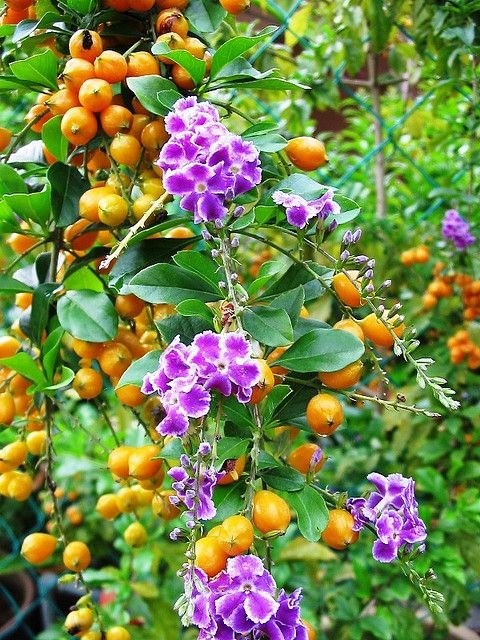 Vibrant purple flowers and golden berries on a Golden Dewdrop shrub, ideal for roadside planting.
Vibrant purple flowers and golden berries on a Golden Dewdrop shrub, ideal for roadside planting.
Periwinkle (Catharanthus roseus)
Commonly known as Madagascar Periwinkle or Vinca rosea, Periwinkle is a resilient flowering plant well-suited for dry, challenging environments often found along roadsides. While the original text describes a tall plant, Periwinkle typically grows as a smaller subshrub or groundcover, reaching about 30-60 cm in height, but its tolerance for harsh conditions makes it relevant. It features glossy green leaves and vibrant flowers in shades of pink, white, and rosy-red, blooming profusely throughout warmer months. Periwinkle thrives in full sun and poor soil, requiring minimal water once established, making it an excellent, low-maintenance option for adding continuous color to arid areas near pavement.
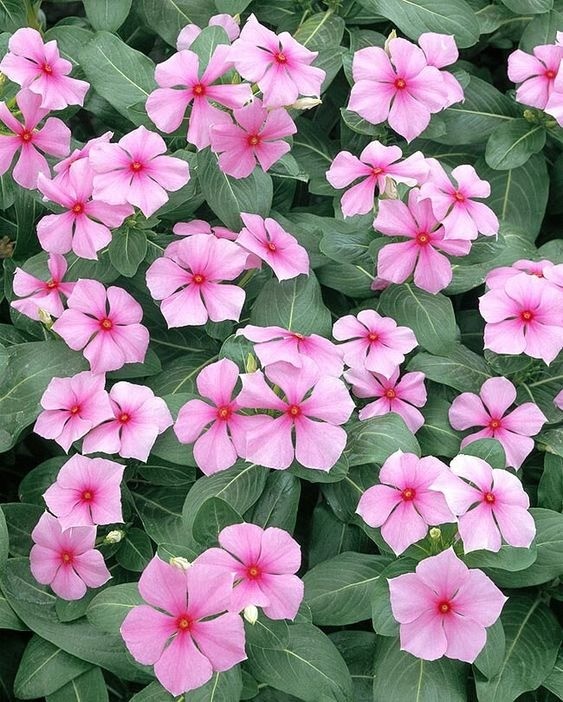 Pink and white Periwinkle flowers blooming among green leaves, showing its suitability as a hardy groundcover.
Pink and white Periwinkle flowers blooming among green leaves, showing its suitability as a hardy groundcover.
Lobster Claw Heliconia (Heliconia rostrata)
Lobster Claw Heliconia is a striking ornamental plant belonging to the Heliconia family. Unlike typical fruit-bearing banana plants, this species is cultivated for its spectacular, brightly colored bracts, which resemble lobster claws and are not edible. While not a traditional tree, its height and tropical appearance make a bold statement in warm climates. It’s excellent for adding dramatic texture and vibrant, long-lasting color to landscaped areas and can be used effectively as a screen or border along roadsides where space allows and the climate is suitable. Its unique inflorescence is visually captivating.
![]() Bright red and yellow 'lobster claw' bracts of a Heliconia plant, showcasing its tropical beauty.
Bright red and yellow 'lobster claw' bracts of a Heliconia plant, showcasing its tropical beauty.
Crape Myrtle (Lagerstroemia species)
Crape Myrtle is a widely popular deciduous tree or large shrub celebrated for its prolific and long-lasting summer flowers. Introduced and widely planted in many regions, including Vietnam, it’s a favorite for landscape design due to its significant aesthetic value, particularly when in bloom. These trees typically reach heights of 10 to 20 meters, featuring beautiful bark and attractive foliage. The flowers appear in large clusters and come in shades of purple, pink, white, or red, transforming streets and parks into colorful spectacles during summer and early autumn.
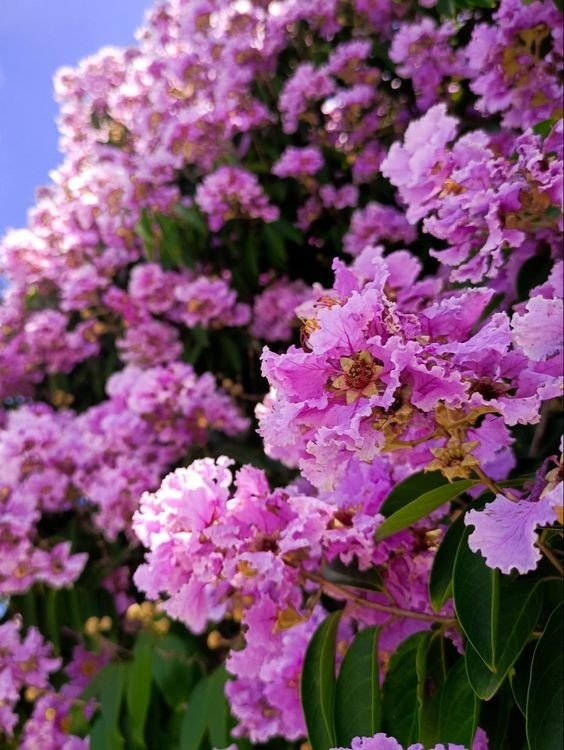 Clusters of vibrant purple flowers on a Crape Myrtle tree, a popular choice for ornamental landscaping.
Clusters of vibrant purple flowers on a Crape Myrtle tree, a popular choice for ornamental landscaping.
Golden Shower Tree (Cassia fistula)
The Golden Shower Tree, also known as Indian Laburnum or Pudding-Pipe Tree, is a magnificent flowering tree belonging to the legume family (Fabaceae). It is highly adaptable and can thrive even in relatively harsh climates. Renowned for its stunning display, this tree can grow to heights of 10-20 meters and is celebrated for its bright yellow flowers and distinctive seed pods. When in full bloom, the tree is covered in cascading clusters of vibrant yellow flowers, creating a breathtaking spectacle that delights onlookers and brings a cheerful atmosphere to streetscapes.
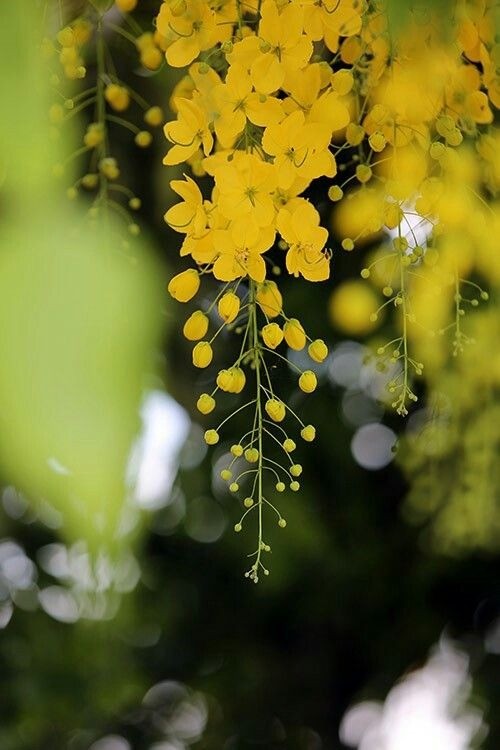 Long, hanging clusters of bright yellow flowers covering a Golden Shower tree, a dazzling sight.
Long, hanging clusters of bright yellow flowers covering a Golden Shower tree, a dazzling sight.
Pink Trumpet Tree (Handroanthus impetiginosus)
The Pink Trumpet Tree is a deciduous tree frequently planted for its spectacular floral display, making it a favored choice for beautifying roadsides, public spaces, and as an ornamental tree. This tree can reach heights ranging from 10 to 20 meters, depending on its growing location and environmental conditions. It features a sturdy trunk and dense green foliage with oval leaves. In spring or early summer, before the leaves fully emerge, the tree is covered in abundant clusters of trumpet-shaped flowers ranging in color from pink to bright red, creating a vibrant and elegant landscape that is highly appealing for street planting.
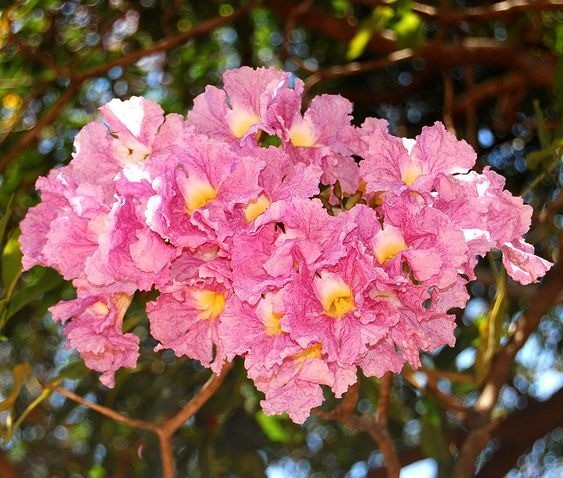 A dense canopy of bright pink trumpet-shaped flowers on a Pink Trumpet tree, showcasing its stunning spring bloom.
A dense canopy of bright pink trumpet-shaped flowers on a Pink Trumpet tree, showcasing its stunning spring bloom.
Pink Shower Tree (Cassia javanica)
The Pink Shower Tree is a beautiful flowering tree widely planted in Vietnam and other tropical regions. It is a relatively large tree, capable of reaching heights of up to 20 meters, providing ample shade to the surrounding area. This makes it one of the most desirable trees for street planting. The flowering period for this tree extends from April to June annually, during which its branches become laden with delicate pink-purple flowers, creating a graceful and eye-catching display. The tree’s form and specific care requirements are distinct, making it a valuable addition to urban forestry.
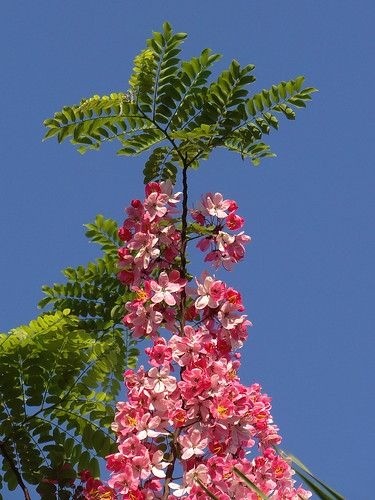 Soft pink-purple flowers covering the branches of a Pink Shower tree against a blue sky, a gentle beauty.
Soft pink-purple flowers covering the branches of a Pink Shower tree against a blue sky, a gentle beauty.
Golden Trumpet Tree (Handroanthus chrysotrichus)
The Golden Trumpet Tree is another wonderfully vibrant flowering tree commonly cultivated and cherished in many parts of the world, including Vietnam. There are several varieties of this tree, but they are primarily known for their striking yellow, trumpet-shaped flowers that bloom profusely. What could be more delightful than planting a tree that not only beautifies your space with stunning flowers but also provides welcome shade? This tree offers a spectacular golden display when in bloom, making it an excellent choice for adding cheerful color and shade to public areas.
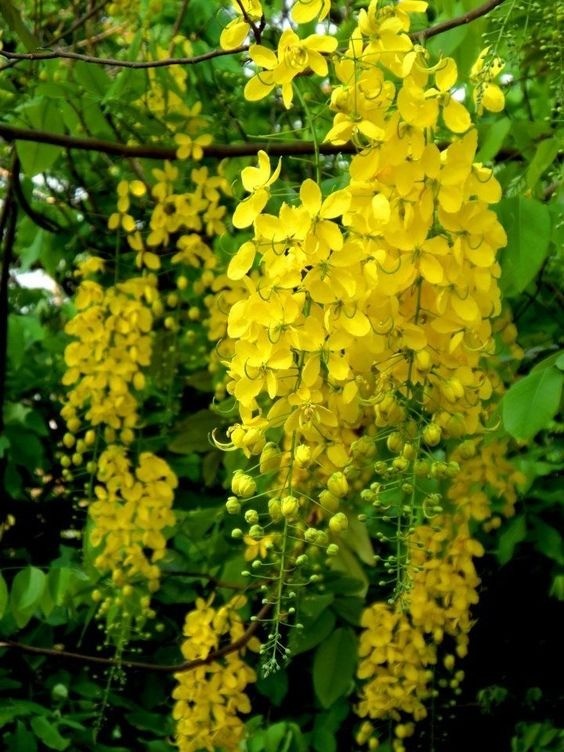 A tree covered in bright yellow trumpet-shaped flowers, creating a sunny, cheerful appearance.
A tree covered in bright yellow trumpet-shaped flowers, creating a sunny, cheerful appearance.
Cherry Blossom (Prunus species)
Cherry Blossom trees are celebrated woody plants originating from China, Japan, and Korea, now adored globally for their exquisite beauty when flowering in spring. These trees are iconic, symbolizing youth, ephemeral beauty, and the hopeful renewal of life. Widely planted and loved for their beautiful blossoms and delightful fragrance, Cherry Blossom trees come in many varieties with different flower colors, including various shades of pink, white, red, and even yellow. Adding the delicate beauty of this street-side flowering tree makes any space truly wonderful.
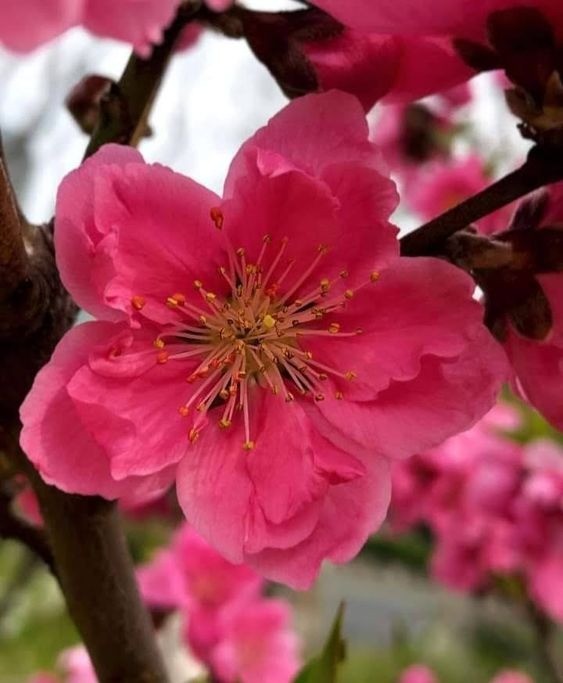 Delicate pink Cherry Blossom flowers in bloom on tree branches against a blurred background, a symbol of spring beauty.
Delicate pink Cherry Blossom flowers in bloom on tree branches against a blurred background, a symbol of spring beauty.
Cosmos (Cosmos bipinnatus)
Cosmos is an herbaceous annual flowering plant often grown as an ornamental or garden decoration. It typically grows to a height of 1-2 meters and features large, daisy-like flowers with a wide array of colors, including red, yellow, pink, white, and orange. Cosmos plants are generally easy to grow and maintain, thriving in various soil types and weather conditions, and often bloom continuously throughout the year in suitable climates. They are seen as symbols of simplicity, joy, and the blossoming of love, bringing a light, airy beauty when planted along roadsides or in adjacent beds.
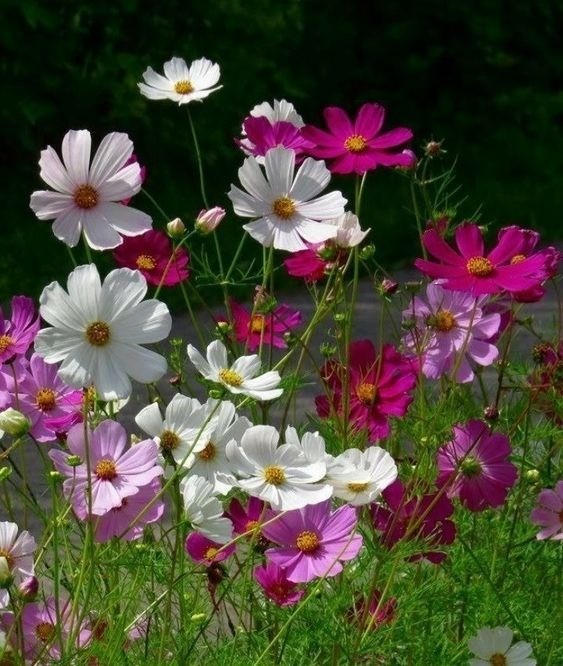 Bright pink and white Cosmos flowers with yellow centers in a garden bed, showing their cheerful appearance.
Bright pink and white Cosmos flowers with yellow centers in a garden bed, showing their cheerful appearance.
Silk Cotton Tree (Bombax ceiba)
The Silk Cotton Tree, also known as the Red Silk Cotton Tree or Bombax, is a large deciduous tree native to Asia. With the scientific name Bombax ceiba, it is often planted along roadsides for its spectacular, large red flowers that appear when the tree is bare of leaves. The Silk Cotton Tree can reach imposing heights of over 30 meters and can live for hundreds of years. Its striking red blossoms make it a dramatic and beautiful choice for large-scale roadside planting, providing a vibrant splash of color during its flowering season.
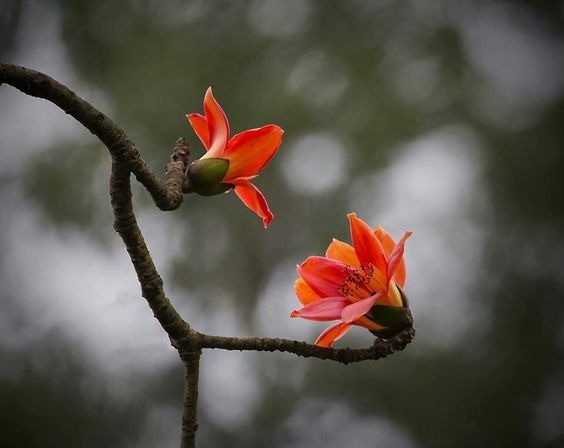 Large, bright red flowers blooming directly on the trunk and branches of a Silk Cotton tree.
Large, bright red flowers blooming directly on the trunk and branches of a Silk Cotton tree.
Globe Amaranth (Gomphrena globosa)
Globe Amaranth, also known as Bachelor’s Button, is an herbaceous plant featuring distinctive purple or pink globe-shaped flowers that hold their color well, even when dried. Originating from the Americas, it is a globally popular species cultivated as an ornamental flower and also used in traditional medicine and as a food source. Globe Amaranth is well-suited for planting in regions with hot and humid climates and can also be grown in pots for home decoration. Besides its ornamental value, this species is valued in folk medicine for treating various ailments like fever, diarrhea, sore throat, and breathing difficulties. Its hardiness and long-lasting blooms make it a good choice for low borders or beds along roadsides.
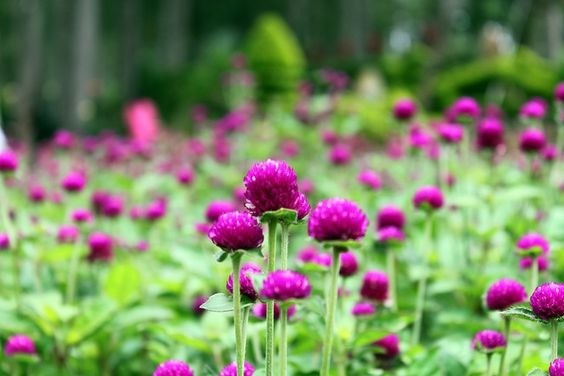 Clusters of small, vibrant purple Globe Amaranth flowers with clover-like texture.
Clusters of small, vibrant purple Globe Amaranth flowers with clover-like texture.
Essential Care Tips for Roadside Flowers
Caring for plants along roadsides involves fundamental practices to ensure their healthy growth and maintain the aesthetic appeal of the landscaped area. Here are some key care recommendations:
- Regular Watering: Ensure plants receive adequate water, particularly during the establishment phase and dry periods. However, avoid overwatering, which can lead to root rot and damage.
- Appropriate Fertilization: Provide suitable organic or chemical fertilizers to ensure plants receive necessary nutrients. Follow specific guidelines regarding the type, amount, and timing of fertilization based on the plant species.
- Periodic Pruning: Perform regular pruning to remove dead, damaged, or unnecessary branches, leaves, and spent flowers. This improves air circulation and light penetration, promoting healthier growth and helping the plant maintain a balanced and tidy shape.
- Pest and Disease Monitoring: Monitor plants frequently to detect early signs of pests, diseases, fungi, and other harmful insects. If any issues are discovered, implement control measures such as using appropriate pesticides or organic treatments.
- Site Cleaning: Keep the area around the plants clean and free from litter. Remove fallen leaves, dead branches, and other debris to prevent creating environments favorable to pests and diseases.
- Light Management: Ensure plants receive sufficient sunlight, while also avoiding excessive light exposure or insufficient light. Adjust any sheltering structures like screens or use pruning to create ideal light conditions for the specific plants.
- Regular Inspection: Observe plants regularly to identify any problems early on and take necessary action. Inspect soil, leaves, fruits, and roots to ensure plants are growing healthily and not experiencing any issues.
At Biogarden.asia, we provide information on some of the most recommended flowering trees and plants for street-side planting today. These species not only produce beautiful flowers that refresh the landscape but also help purify the air quite effectively. We hope this information helps you discover new ideas for selecting plants to enhance your roadsides and public spaces. Consider exploring our selection of high-quality plants and gardening products to bring these beautiful visions to life.



